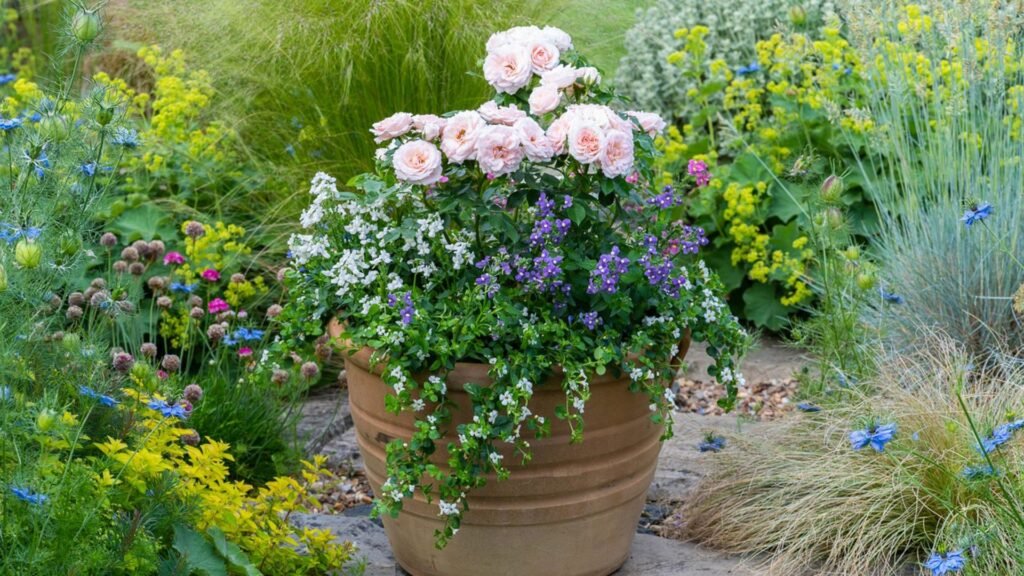|
Getting your Trinity Audio player ready...
|
Potted flowers bring vibrant splashes of colour and natural beauty to any space, be it a balcony, porch, or indoors. However, ensuring these potted blooms thrive requires careful attention and specific care practices. In this guide, we’ll explore the essential steps to keep your potted flowers healthy and flourishing.

1. Choosing the Right Pots
When embarking on your potted flower journey, select pots with drainage holes to prevent waterlogging. Opt for containers that match the size of your plants, providing ample room for root expansion.
2. Selecting the Ideal Soil
Use well-draining, nutrient-rich soil for potted flowers. Consider a mix designed for container gardening to ensure proper aeration and water retention.
3. Watering Wisely
Find the delicate balance in watering – too little may lead to dehydration, while excessive watering can drown the roots. Check the soil moisture regularly and adjust watering accordingly.
4. Providing Adequate Sunlight
Most flowering plants thrive in sunlight. Place your potted flowers in locations that receive the right amount of sunlight for their specific needs. Be mindful of the sunlight requirements of each plant.
5. Feeding with Fertilizers
Potted flowers rely on you for nutrients. Use a balanced, water-soluble fertilizer to nourish your plants during the growing season. Follow the recommended application rates for each type of flower.
6. Pruning and Deadheading
Regularly remove spent flowers and prune to encourage new growth. This not only maintains a tidy appearance but also stimulates the plant to produce more blooms.
7. Managing Pests
Keep an eye out for pests that may infest potted flowers. Inspect the leaves regularly, and if you spot any unwanted visitors, use organic pest control methods to protect your plants.
8. Supporting Tall Plants
If you have tall or vining flowers, provide stakes or supports to prevent them from bending or breaking. This is especially crucial during periods of strong winds.
9. Monitoring Temperature and Humidity
Be aware of temperature fluctuations and humidity levels, especially if your potted flowers are indoors. Most plants have specific temperature and humidity preferences for optimal growth.
10. Repotting When Necessary
As your potted flowers grow, they may outgrow their containers. Repot them into larger pots to provide ample space for root development.
11. Winterizing Potted Flowers
If you live in a region with harsh winters, consider winterizing your potted flowers. Move them to a protected area, reduce watering, and provide insulation to shield them from the cold.
12. Rotating for Balanced Growth
Rotate your potted flowers occasionally to ensure even exposure to sunlight. This prevents the plants from leaning towards one direction and promotes balanced growth.
13. Choosing Companion Plants:
Some plants thrive when planted together due to mutual benefits. Research companion planting to create harmonious potted arrangements that support each other’s growth.
14. Mulching for Moisture Retention:
Apply a layer of organic mulch around the base of your potted flowers. Mulching helps retain soil moisture, regulates temperature, and suppresses weed growth.
15. Choosing the Right Watering Time:
Water your potted flowers in the morning or late afternoon to minimize evaporation. This ensures the plants have sufficient moisture during the day without the risk of waterlogged soil overnight.
16. Monitoring Soil pH:
Check and adjust the soil pH if necessary. Some flowers prefer slightly acidic soil, while others thrive in alkaline conditions. Use a pH testing kit and amend the soil accordingly.
17. Regular Soil Inspection:
Periodically inspect the soil for signs of compaction or disease. Aerating the soil and addressing issues promptly can prevent potential problems and promote overall plant health.
18. Proper Watering Technique:
Water the base of the plants directly to ensure the roots receive moisture. Avoid wetting the foliage excessively, as this can lead to fungal diseases.
19. Protecting from Harsh Elements:
Shield your potted flowers from extreme weather conditions, such as heavy rain, strong winds, or intense sunlight. Move them to a sheltered area when needed to prevent stress on the plants.
20. Observing Leaf Color and Texture:
Pay attention to the colour and texture of the leaves. Yellowing or wilting may indicate nutrient deficiencies or overwatering, while dry and crispy leaves could signal underwatering.
21. Introducing Beneficial Insects:
Encourage beneficial insects like ladybugs or predatory beetles in your potted garden. They can help control harmful pests naturally, contributing to a healthier plant environment.
22. Using Organic Compost:
Furthermore, enrich the soil with organic compost regularly to enhance its fertility. This provides a steady supply of nutrients to your potted flowers, promoting robust growth.
23. Customizing Watering Frequency:
Tailor the watering frequency based on individual plant needs. Some flowers prefer consistently moist soil, while others thrive in slightly drier conditions. Additionally, adjust your watering schedule accordingly.
24. Applying Epsom Salt for Magnesium:
Hence, occasionally supplement your potted flowers with a diluted Epsom salt solution to boost magnesium levels. This can enhance flower colour and overall plant vitality.
By following these comprehensive care tips, you’ll create an environment where your potted flowers not only survive but thrive, bringing continuous joy with their vibrant blossoms.

